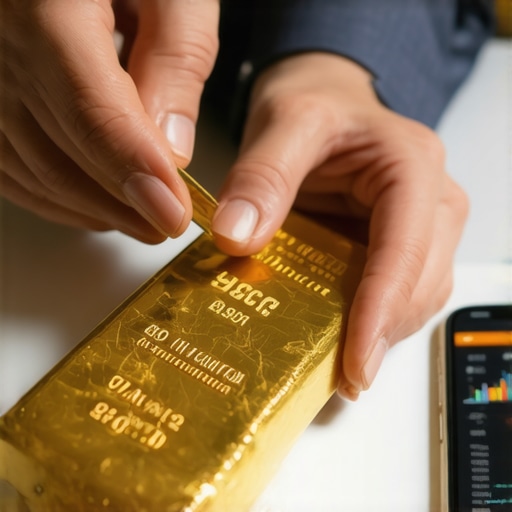Unlocking the Golden Gateway: Why Start with Gold Stocks?
Investing in gold has long been a beacon of financial security and wealth preservation. For beginners, gold stocks offer an accessible and potentially lucrative entry point into the precious metals market without the complexities of physical ownership. Unlike bullion or coins, gold stocks represent shares in companies engaged in gold mining or exploration, blending the allure of gold’s intrinsic value with the dynamics of the stock market.
Decoding the Glitter: Key Criteria to Evaluate Before Buying Your First Gold Stock
Choosing your first gold stock isn’t just about picking a shining name; it requires careful scrutiny of several factors. Focus on the company’s financial health, mining assets quality, production costs, and management expertise. For instance, companies with low all-in sustaining costs (AISC) typically outperform during price dips, offering a margin of safety. Also, consider geopolitical risks linked to the mining locations, as political stability can significantly impact operations and stock performance.
How Does Market Volatility Affect Gold Stocks Compared to Physical Gold?
Gold stocks tend to be more volatile than physical gold, as their prices reflect not only gold price fluctuations but also company-specific risks and broader market sentiment. While physical gold is a direct hedge against inflation and currency devaluation, gold stocks introduce operational and market risks. This dual exposure can amplify gains during bullish cycles but also exacerbate losses during downturns. Understanding this dynamic helps investors balance their portfolios more effectively, possibly by combining stocks with physical gold or ETFs for diversified exposure. For a detailed beginner’s guide on physical gold investment, you can explore this resource.
Unearthing Hidden Gems: Identifying Promising Gold Stocks Beyond Market Hype
Not all gold stocks glitter equally. Beyond industry giants, emerging mid-tier and junior mining companies can offer substantial growth potential, albeit with higher risk. Look for companies with promising exploration projects, strong balance sheets, and a clear strategy for sustainable growth. Monitoring gold demand trends and mining innovations also provides clues to future winners. Authoritative insights from the World Gold Council highlight how demand shifts influence stock performances, reinforcing the need for informed selection (World Gold Council Research).
Safeguard Your Golden Investment: Practical Tips for First-Time Gold Stock Investors
Start with small, well-researched investments and consider diversifying across several stocks or gold ETFs to mitigate risk. Utilize trusted platforms and keep abreast of market analyses and price forecasts. Regularly review your portfolio in light of global economic indicators affecting gold prices. For comprehensive strategies tailored to beginners, the article Investing in Gold for Beginners: Essential Steps to Get Started is invaluable.
Engage and Elevate: Share Your Journey or Questions About Gold Investing
Embarking on your gold investment journey can be both exciting and complex. If you have experiences or questions about choosing your first gold stock, share them in the comments below. Your insights could be the golden key for many fellow beginners seeking clarity and confidence.
Leveraging Gold ETFs for Diversified Exposure Beyond Stocks
While gold stocks provide direct exposure to mining companies, investors seeking diversification and reduced company-specific risk often turn to gold ETFs. These exchange-traded funds bundle numerous gold assets, including physical gold and shares of multiple mining companies, offering a balanced approach to capturing gold market gains. ETFs typically have lower volatility compared to individual gold stocks and provide liquidity advantages, making them an attractive option for both beginners and seasoned investors. For a comprehensive overview on selecting the right gold ETFs, consider reading Gold ETFs 101: How to Choose the Right Fund for Your Goals.
Understanding the Impact of Global Economic Indicators on Gold Stocks
The price of gold and consequently gold stocks are highly sensitive to global economic indicators such as inflation rates, interest rates, and geopolitical tensions. For example, rising inflation often boosts gold prices as investors seek inflation hedges, benefiting gold mining companies’ profitability. Conversely, increasing interest rates can strengthen the dollar and diminish gold’s appeal. Additionally, mining stocks can be influenced by operational factors like labor disputes or regulatory changes in mining jurisdictions. Staying updated on macroeconomic trends and mining sector news is crucial for timely investment decisions. Trusted financial news outlets and analytical reports like those from the World Gold Council provide invaluable insights into these dynamics (World Gold Council Research).
What Are the Most Effective Risk Management Techniques When Investing in Gold Stocks?
Managing risk in gold stock investments involves several strategic approaches. Diversification across multiple companies and sub-sectors within the gold industry can reduce exposure to company-specific or regional risks. Utilizing stop-loss orders helps limit downside during volatile market swings. Moreover, blending gold stocks with physical gold or low-cost ETFs can balance volatility and preserve capital. Regular portfolio rebalancing aligned with shifting economic conditions ensures your investment remains optimized. For investors new to this complex market, educational resources such as Effective Gold Investment Strategies to Boost Your Wealth offer practical guidance on risk mitigation.
Exploring Junior Gold Miners: High Risk, High Reward?
Junior gold mining companies often represent the frontier of gold exploration and development. These smaller firms typically have lower production volumes but higher growth potential due to new discoveries or expansion projects. However, their stocks can be highly volatile and susceptible to financing challenges, exploration results, and commodity price swings. Investing in juniors requires rigorous due diligence, including analysis of their project pipelines, cash flow status, and management track records. For those with a higher risk tolerance, juniors can provide significant portfolio growth but should be balanced with more stable assets.
To deepen your understanding of safe investment practices in physical gold and related assets, review the Beginners Guide to Physical Gold Investment.
Integrating Gold Stocks Within a Comprehensive Investment Portfolio
Gold stocks should be considered part of a broader portfolio strategy. Their role as a hedge against inflation and market uncertainty complements equities, bonds, and alternative assets. Strategic allocation — typically between 5% to 15% of overall portfolio value — allows investors to capitalize on gold’s unique characteristics without overexposure. Additionally, pairing gold stocks with physical gold or ETFs can mitigate the volatility inherent to mining companies. Continual assessment of portfolio performance and alignment with financial goals is essential for optimizing returns.
For an expert perspective on portfolio diversification strategies involving gold, check out Smart Gold Investment Strategies: Diversify with Stocks and Bars.
Mastering Volatility: Advanced Risk Mitigation Techniques for Gold Stock Portfolios
Investing in gold stocks requires more than just an understanding of market fundamentals; it demands a sophisticated approach to risk management. Beyond basic diversification and stop-loss orders, seasoned investors employ dynamic hedging strategies using options and futures contracts to protect against adverse price swings. This approach allows a portfolio to maintain upside exposure while capping potential losses during turbulent markets.
Another nuanced technique involves volatility timing—adjusting exposure to gold stocks based on implied and historical volatility metrics. By monitoring the VIX index alongside gold-specific volatility indicators, investors can tactically increase or decrease holdings, optimizing risk-adjusted returns. Additionally, incorporating scenario analysis and stress testing on your portfolio can reveal vulnerabilities linked to geopolitical shocks or sudden regulatory changes affecting mining operations.
Can Advanced Derivative Strategies Enhance Returns While Controlling Risk in Gold Stocks?
Indeed, derivatives such as options provide a powerful toolkit for sophisticated investors aiming to fine-tune their risk-return profile. Writing covered calls on gold stocks can generate premium income, effectively lowering the cost basis and providing a cushion against moderate price declines. Conversely, purchasing protective puts offers insurance against sharp downturns, albeit at a premium cost. Combining these strategies in collars can create defined risk zones, allowing strategic participation in gold’s upside with limited downside exposure.
However, successful implementation requires a deep understanding of option pricing models, implied volatility trends, and the underlying stock’s behavior. This complexity underscores why these strategies are often preferred by experienced investors or those consulting with financial professionals specialized in commodities and precious metals markets.
In-Depth Analysis: How Geological and Technological Innovations Shape Gold Stock Valuations
Gold stock valuations are profoundly influenced by advances in geological exploration techniques and mining technology. Modern methods such as 3D seismic imaging and AI-driven data analytics enhance ore body modeling, enabling companies to identify richer deposits with greater precision and lower costs. These improvements can significantly uplift a company’s reserve estimates and expected mine life, directly impacting stock valuations.
Moreover, the adoption of sustainable mining technologies—like bioleaching and renewable energy integration—can reduce environmental impact and operational expenses, appealing to ESG-conscious investors. Firms leading in these innovations often command premium valuations due to their improved risk profiles and alignment with global sustainability trends.
Staying abreast of technological breakthroughs and geological discoveries requires continuous engagement with specialized mining reports and industry conferences. Resources such as the Society for Mining, Metallurgy & Exploration (SME) provide cutting-edge research and networking opportunities invaluable for discerning investors.

Strategic Portfolio Allocation: Integrating Gold Stocks with Alternative Assets for Optimal Growth
Gold stocks should not exist in a vacuum within an investment portfolio. Advanced strategies advocate blending gold equities with alternative assets such as real estate investment trusts (REITs), infrastructure funds, and even cryptocurrencies to harness non-correlated return streams. This multidimensional diversification can smooth portfolio volatility and enhance long-term growth potential.
Additionally, tactical allocation shifts guided by macroeconomic signals—such as monetary policy changes or fiscal stimulus—can optimize entry and exit points for gold stock exposure. Employing quantitative models that factor in interest rate trends, inflation expectations, and currency movements further refines timing decisions. These approaches elevate investing from reactive to proactive, positioning portfolios to capitalize on gold’s cyclical dynamics effectively.
For investors aiming to deepen their strategic acumen, exploring advanced portfolio theory and incorporating gold stock analytics into comprehensive asset allocation models is recommended. Scholarly journals like the Journal of Portfolio Management often publish relevant studies illuminating these integration techniques.
Where Can Investors Access Authoritative Data and Tools to Implement These Advanced Strategies?
Access to high-quality data and analytical tools is critical. Platforms such as Bloomberg Terminal and FactSet provide real-time commodity pricing, corporate financials, and macroeconomic indicators essential for informed decision-making. Additionally, specialized mining analytics services like S&P Global Market Intelligence offer granular insights into production costs, reserve estimates, and company-specific risks.
Engaging with these resources, while leveraging expert consultation, empowers investors to navigate the complexities of gold stock investing with confidence and precision.
Ready to elevate your gold investment strategy? Dive deeper into professional-grade analysis and connect with seasoned experts to refine your portfolio today.
Harnessing Cutting-Edge Analytics: The Role of Big Data in Gold Stock Selection
In the increasingly complex landscape of gold stock investing, the integration of big data analytics offers a decisive edge. Investors now leverage sophisticated algorithms to process vast datasets—ranging from geological surveys and production metrics to geopolitical risk indicators—enabling nuanced evaluation of mining companies’ potential. These insights facilitate identifying undervalued stocks and anticipating market shifts ahead of conventional analysis.
Machine learning models can detect subtle patterns in commodity price movements and correlate them with operational performance, offering predictive capabilities that transcend traditional fundamental analysis. Embracing such technologies aligns with the cutting edge of investment research and empowers investors to refine their decision-making frameworks significantly.
Decoding ESG Impact: How Sustainability Metrics Influence Gold Stock Valuations and Investor Confidence
Environmental, Social, and Governance (ESG) criteria have become pivotal in assessing gold mining companies’ long-term viability. Firms demonstrating robust ESG practices often attract premium valuations, as they mitigate regulatory risks and appeal to a growing base of socially responsible investors. Critical factors include adherence to sustainable mining protocols, community engagement, and transparent governance structures.
Recent studies reveal a positive correlation between high ESG scores and reduced operational disruptions, which translates to more stable cash flows and enhanced shareholder value. Consequently, discerning investors incorporate ESG analytics into their valuation models to uncover companies poised for sustainable growth.
How Can Investors Quantify and Integrate ESG Factors into Their Gold Stock Investment Decisions?
Quantification of ESG factors involves analyzing standardized ESG ratings provided by specialized agencies such as MSCI or Sustainalytics. These ratings assess criteria like carbon footprint, labor practices, and board diversity, translating qualitative data into actionable scores. Investors can integrate these metrics alongside financial indicators using multi-factor models to balance ethical considerations with profitability.
Moreover, engaging directly with company disclosures and sustainability reports adds depth to the evaluation process. Authoritative guidance on ESG integration is available through the MSCI ESG Investing Framework, a leading resource for embedding ESG into investment analysis.
Strategic Hedging with Gold Derivatives: Balancing Opportunity and Protection
Beyond conventional stock holdings, advanced investors employ derivatives such as gold futures and options to hedge portfolio risk dynamically. These instruments enable tailored exposure management, allowing for protective positioning against adverse price movements while retaining upside potential.
For example, using options strategies like protective puts or collars can create defined risk parameters, crucial in volatile market environments. Additionally, futures contracts provide liquidity and leverage advantages but require rigorous margin and risk management. Mastery of these tools necessitates sophisticated understanding and continuous market monitoring.
Collaborative Intelligence: Leveraging Expert Networks and Industry Conferences for Informed Investing
In the realm of gold stocks, staying ahead demands more than solitary analysis. Participating in industry-specific forums and mining conferences fosters access to emerging trends, regulatory updates, and technological innovations. Networking with industry experts and analysts elevates investors’ perspectives and uncovers nuanced insights often absent from public disclosures.
Organizations such as the Society for Mining, Metallurgy & Exploration (SME) facilitate continuous professional development and provide authoritative research indispensable for deep sector understanding.

Elevating Portfolio Dynamics: Integrating Gold Stocks with Quantitative Models and Alternative Assets
To optimize return-risk profiles, sophisticated investors incorporate quantitative portfolio optimization techniques that factor in gold stocks’ unique volatility and correlation characteristics. Combining these equities with alternative assets such as infrastructure funds, real estate, and select cryptocurrencies can generate diversified streams that enhance overall portfolio resilience.
Advanced strategies employ scenario analysis and stress testing to calibrate allocations responsive to macroeconomic shifts, enhancing tactical agility. The application of such models is supported by academic research published in journals like the Journal of Portfolio Management, which underscores the benefits of multi-asset integration.
Where Can Investors Access Authoritative Data and Tools to Implement These Advanced Strategies?
High-caliber data access is paramount for executing sophisticated gold stock investment strategies. Platforms including Bloomberg Terminal and FactSet offer comprehensive real-time data encompassing commodity prices, financial statements, and geopolitical risk factors. Complementing these are niche analytics providers like S&P Global Market Intelligence, which deliver granular mining sector insights such as reserve quantities and production cost breakdowns.
Coupling these resources with expert advisory services enables investors to develop robust, data-driven portfolios that balance growth potential with risk mitigation effectively.
Ready to elevate your gold investment strategy? Harness professional-grade analytics, leverage cutting-edge technologies, and connect with seasoned experts to transform your portfolio performance today.
Frequently Asked Questions (FAQ)
What are the primary differences between investing in gold stocks and physical gold?
Gold stocks represent shares in companies involved in gold mining or exploration, subject to operational, geopolitical, and market risks, resulting in higher volatility compared to physical gold. Physical gold provides direct exposure as a tangible asset, often considered a safe haven and inflation hedge, but lacks dividend yield and liquidity flexibility. Combining both can diversify risk and optimize portfolio stability.
How do geopolitical factors impact gold stock investments?
Geopolitical stability in mining regions critically affects gold mining operations, influencing production continuity, regulatory policies, and operational costs. Political unrest or adverse government actions can disrupt supply chains and investor sentiment, leading to stock price volatility. Evaluating a company’s geographic risk exposure is essential when selecting gold stocks.
What metrics should I prioritize when evaluating a gold mining company?
Key metrics include all-in sustaining costs (AISC), reserve and resource quality, production growth potential, cash flow stability, and management track record. Low AISC companies typically maintain profitability even during gold price downturns. Additionally, ESG performance increasingly influences long-term viability and investor appeal.
Can investing in junior gold miners be suitable for beginners?
Junior miners offer high growth potential but carry significant risks such as financing difficulties, exploration uncertainties, and operational challenges. Beginners should approach juniors cautiously, performing rigorous due diligence and balancing exposure with more stable gold equities or ETFs to mitigate volatility.
How can ESG factors influence gold stock valuations and investor decisions?
Strong ESG practices reduce operational risks and enhance corporate reputation, often resulting in premium valuations. Investors increasingly incorporate ESG ratings and sustainability disclosures into their decision-making to identify companies aligned with regulatory trends and socially responsible investing principles.
What advanced risk management techniques are effective for gold stock portfolios?
Beyond diversification and stop-loss orders, strategies include options-based hedging (protective puts, collars), volatility timing based on market indicators like the VIX, and scenario stress testing. These techniques help control downside risk while maintaining upside exposure in volatile markets.
How do technological innovations impact gold mining companies and stock valuations?
Innovations such as AI-driven geological modeling and sustainable mining technologies improve resource identification, reduce costs, and enhance environmental compliance. Companies leading in these areas often achieve higher valuations due to improved operational efficiency and ESG profiles.
What role do gold ETFs play compared to direct gold stock investments?
Gold ETFs provide diversified exposure to a basket of gold assets, including physical gold and multiple mining stocks, reducing company-specific risk and volatility. They offer liquidity and ease of trading, making them suitable for investors seeking broad gold market participation without the complexities of individual stock selection.
Where can I find reliable data and tools to support advanced gold stock investing?
Professional platforms such as Bloomberg Terminal, FactSet, and S&P Global Market Intelligence offer comprehensive real-time data on commodity prices, company financials, and geopolitical risks. Coupling these with expert advisory services facilitates informed, data-driven investment decisions.
How should gold stocks be integrated into a diversified investment portfolio?
Gold stocks typically constitute 5% to 15% of a diversified portfolio, serving as a hedge against inflation and market volatility. Combining gold stocks with physical gold, ETFs, and alternative assets like REITs and cryptocurrencies enhances diversification and risk-adjusted returns through complementary performance drivers.
Trusted External Sources
World Gold Council (https://www.gold.org/): The premier authority on gold market research, providing comprehensive data, industry analysis, and insights into gold demand, supply dynamics, and investment trends critical for evaluating gold stocks.
Society for Mining, Metallurgy & Exploration (SME) (https://www.smenet.org/): A leading professional organization offering cutting-edge research, technical papers, and industry updates on mining technologies and practices, essential for understanding operational factors affecting gold mining companies.
MSCI ESG Investing Framework (https://www.msci.com/our-solutions/esg-investing): A globally recognized ESG rating provider delivering detailed sustainability metrics and integration guidelines, vital for incorporating ESG considerations into gold stock investment strategies.
Bloomberg Terminal (https://www.bloomberg.com/professional/solution/bloomberg-terminal/): An indispensable platform for real-time financial data, commodity prices, and macroeconomic indicators that underpin advanced gold stock portfolio management and trading decisions.
Journal of Portfolio Management (https://jpm.iijournals.com/): A scholarly publication featuring research on portfolio theory and asset allocation, including multi-asset strategies involving gold stocks and alternative investments, supporting evidence-based portfolio construction.
Conclusion
Investing in gold stocks offers a compelling blend of exposure to the precious metals market and equity growth potential, but it demands a nuanced understanding of operational, geopolitical, technological, and ESG factors. From evaluating key financial metrics and managing volatility through advanced derivative strategies to integrating gold equities within diversified portfolios, a strategic and informed approach is essential. Leveraging authoritative data sources, embracing technological innovation, and considering sustainability metrics further refine investment decisions, positioning investors to harness gold stocks’ unique benefits effectively. Whether you are starting with blue-chip miners or exploring junior companies, balancing risk with opportunity through comprehensive analysis and ongoing portfolio adjustment remains paramount. Engage with expert insights, utilize cutting-edge analytical tools, and share your experiences to elevate your gold investment journey. Explore our related expert content and join the conversation to unlock the full potential of gold stocks in your portfolio today.











What really stood out to me in this post is the importance of evaluating the all-in sustaining costs (AISC) when selecting a gold stock. It makes perfect sense that companies with lower AISC can weather gold price dips better and provide a margin of safety—something that beginners often overlook in favor of brand names or popular stocks. In my own early investments, I initially gravitated toward the big mining giants, but after some market volatility, I realized that incorporating mid-tier companies with strong financial fundamentals can balance risk and growth potential. Another challenging aspect I’ve noticed is assessing geopolitical risks since some mining operations are in regions with unpredictable political climates, which can quickly impact stock performance. Does anyone have strategies for effectively monitoring these geopolitical factors? For example, do you rely on specific news sources or sector reports to stay ahead of potential issues? Also, how do you personally balance the volatility of gold stocks by combining them with physical gold or ETFs in your portfolio? I’d be very interested to hear different approaches from this community, especially those who started with limited knowledge and gradually built confidence in managing this unique asset class.